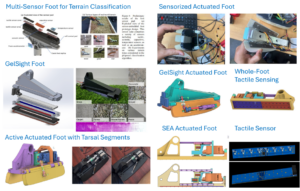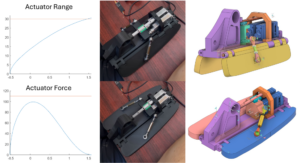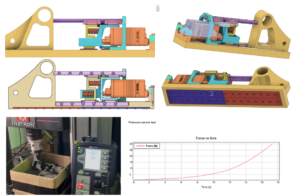Bipedal locomotion on varied terrains poses significant challenges compared to controlled lab environments, which are flat, rigid, and predictable. Natural terrains like sand, gravel, boulders, and grass introduce slipperiness, deformability, and potential sinking, demanding robust adaptability in robot design and control. This project focuses on developing an advanced robotic foot with actuators, sensors, and control algorithms to enable reliable locomotion on diverse terrains. The foot integrates multiple sensors—including accelerometers, microphones, and tactile sensors—for terrain classification using decision tree algorithms. Force-sensing linear actuators with admittance and series elastic actuator (SEA) control enhance compliance and force regulation. Innovative designs, such as a grasp-capable tarsal segment, improve contact reliability. Control algorithms extend angular-momentum-based walking models with double-support phases and passivity dynamics for real-time torque generation, demonstrating practical utility in real-world bipedal locomotion scenarios.
Research Challenge: Bipedal locomotion on diverse terrains is a complex challenge. Unlike controlled lab surfaces—flat, rigid, and predictable—natural terrains like sand, gravel, boulders, and grass are slippery, deformable, and can cause robots to sink. These characteristics require significant advancements in robot design and control to achieve robust locomotion. This project aims to develop an advanced robotic foot equipped with actuators and sensors, alongside upgraded control algorithms, to enable robots to walk reliably on various terrains.
Sensors and Terrain Classification: To identify terrain types and parameters, the foot integrates multiple sensors, including accelerometers, temperature sensors, microphones, contact sensors, and tactile sensors. Terrain data is processed using decision tree algorithms to classify the most likely terrain type.
Force Sensing and Compliance: Force-sensing linear actuators enable active compliance via admittance control. They are further enhanced with series elastic actuators (SEA) to combine passive compliance with precise force control. The foot incorporates 80 tactile force sensors distributed across the sole and tarsal segments, with data fused through a Kalman filter for accurate force sensing.
Innovative Tarsal Segment Design: An active tarsal segment enhances terrain interaction through grasping and compliance to absorb impacts. Its innovative spatial linkage design offers a wide motion range and significant grasping force, validated through real-world testing on the Cassie robot.
Control Algorithm Advancements: Control algorithms extend existing angular-momentum-based linear inverted pendulum models by incorporating a double-support phase for foot contact planning. A passivity-based dynamics controller generates real-time joint torques to ensure stable locomotion.
Summary: This comprehensive approach combines novel hardware and advanced control strategies to address the challenges of bipedal locomotion on complex terrains.




